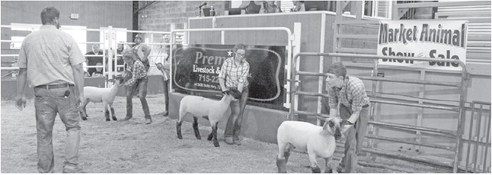Eckert has learned to show lambs from the ground up


He grew up around dairy cows and decided to show lambs
Jacob Eckert, 14, is a self-described farm kid.
He grew up around dairy cows on his family’s farm and for him it was never a question of if he would show animals at the fair, but what kind of animal he would show.
“I wanted to try something different,” Jacob said. Jacob, who will be a sophomore this year at Medford Area Senior High School, has shown sheep for the past seven years.
He said he made the choice to show sheep based on their smaller size and that there were comparatively fewer sheep shown than swine when he started.
“We learned this from the ground up,” explains his mother Karyn Eckert. “I never showed sheep,” she said, noting that her experience was showing dairy and dabbling with pigs and steers.
According to Jacob, genetics is a big part of if an animal will do well and appeal to judges. Jacob shows Hampshire Cross sheep, a breed that is bred for meat and to be shown in the market class.
They purchase the sheep each year from breeder Mark Werner, a Marathon County native who now is based near Rochester, Minn. He is a college friend of his mother. The breeder raises the lambs until they are about two months old at which time Jacob brings them home and works to get them to show quality by fair time. A good breeder is a quality resource, especially for those who are newer to showing a particular type of animal. “He is always available to answer questions,” Karyn said.
The sheep usually weigh between 50 and 60 pounds when Jacob gets them. He explained that the goal is to build mass without building fat. The goal is to have the animal at between 130 and 140 pounds by the time it is shown.
“You don’t want a lot of fat on them, they want them pretty lean,” he said, noting there is no market for lamb fat. He said one of the key things judges look at is the animal’s bone structure and how they walk.
Monitoring food is a major part of the work that Jacob puts in with his animals. He said the rate of gain is important to watch and that they have to keep track of feed to get the animals at the target weight to be showed.
Jacob said the amount of time he works with the animals vary. He spends a few hours each day walking and feeding them and a few times over the summer he will have to sheer them. While all sheep have wool, the wool of animals bred for their meat is of low quality compared to varieties bred for their wool. In addition, Jacob attends workshops each year to learn about showing the animals including highlighting what the judges are looking for each year. “Things change a little here or there,” he said.

Kylee Koontz (l. to r.) Ella Ewings and Jacob Eckert keep their eyes on the judge during the market lamb show at the 39th annual Market Animal Show and Sale held on Saturday, July 25.BRIAN WILSON/THE STAR NEWS



